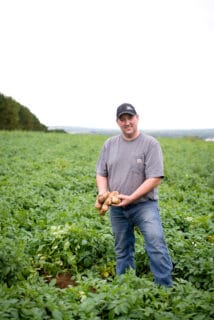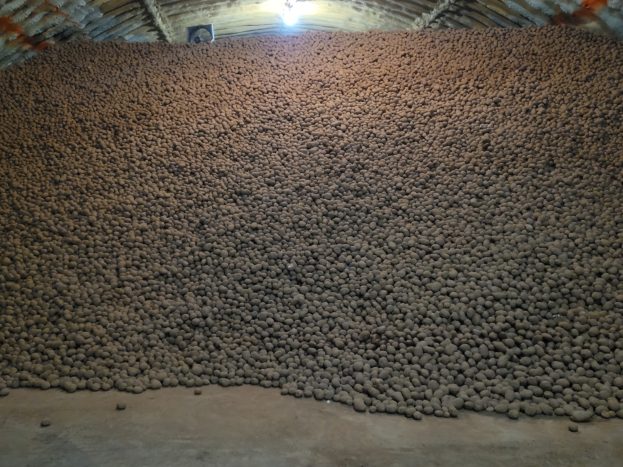Despite challenges and uncertainties, P.E.I. growers got some good trade-related news as the 2022 season begins.
What’s happening in the potato industry right now? Depends where you want to begin.
Trade concerns, weather, input and fuel costs are just a few of the factors on the minds of growers right now, and attendees of 2022 Canadian Spud Congress had a chance to hear from three potato growers with their finger on the pulse of what’s happening in Eastern and Western Canada.
Paramount for growers right now is input costs, attendees heard.

“We’ve been dealing with it as best we can; we’ve been buying stuff ahead of time, but who knows where some of these prices are going to go. You try to budget and plan as much as possible and weigh some of the rotation crops and see which one’s going pay the most and use the least amount of inputs,” says Shawn Paget, who operates Riverview Farms in New Brunswick’s Saint John River Valley.
Paget is currently the president of the New Brunswick Seed Growers’ Co-op and chair of the New Brunswick Grain Commission.
“Things seem really out of control right now with people trying to figure out ways to cut costs going into the season. But my father always said you can’t be cheap and grow a good potato crop. There’s only so much you can cut,” said Prince Edward Island’s Chad Robertson, a sixth-generation farmer at his family’s farm Marvyn’s Garden.
Manitoba’s Sheldon Wiebe of J.P. Wiebe Ltd. agreed input costs are a major concern, but for many growers, buying product in advance can be a challenge.
“We’ve been able to buy some of our inputs in advance, but it’s hard to store everything on farm. Then comes the issue of availability, if you can even get your some of your fertilizers and other things in a timely fashion. We’re doing as much as we can to try and mitigate that.”
P.E.I. Potato Trade Concerns
For Robertson, many concerns have been secondary to the major one facing P.E.I. growers since November — the closure of the United States border to P.E.I. potatoes grown for the fresh and seed markets. It was in November that a potato wart discovery was made, and the border closed to P.E.I. potatoes.

“Things have been at a standstill since a lot of orders were cancelled and it’s been a massive hit to our whole island economy here,” Robertson explains. “The situation was handled poorly. It’s been a tough winter, and everybody has been pretty nervous going into the spring.”
Of course, that all changed on March 24 (just two days after Congress) when the U.S. Department of Agriculture (USDA) announced exports of P.E.I. table stock potatoes to the U.S. would resume.
“As a result of the U.S. and Canada reaching an understanding about the risk of table stock potato imports from P.E.I., Canada will lift its ban while APHIS plans to publish a federal order outlining additional required mitigations to protect the U.S. potato industry,” a USDA news release said.
The USDA has determined fresh potatoes from P.E.I. may resume under specified conditions that will pose little risk of introducing potato wart disease into the U.S., the release notes.

Table stock potatoes must be washed in P.E.I. to remove soil, treated with a sprout inhibitor, and graded to meet the U.S. No. 1 standard. Shipments must then be officially inspected by the NPPO of Canada and certified as meeting USDA requirements, the release says.
For Robertson, the news was more than welcome. While he’s still awaiting details on the resumption, he looks forward to resuming trade with the U.S. and re-establishing relationships with customers there.
“We need to work on getting our industry back on its feet. Steps need to be taken to ensure this border closure doesn’t happen again. We can’t continue to farm with the threat of a closure at any moment hanging over our heads,” he says in an April 1 email.
Drought Difficulties on the Prairies
Of course, P.E.I. wasn’t the only province to face challenges posed by Mother Nature. After the dry 2021 summer in Manitoba, potatoes from the Maritime provinces were being shipped west to Manitoba to fill processor needs.

While overall potato production has increased in the Prairie provinces, processors still don’t have enough raw product to last the entire season. Extreme heat caused size and quality issues with the 2021 crop as well.
“We fared OK this last summer with our crop; we had good quality and good yields. We’ve been fortunate that we’ve pushed as hard as we have with the irrigation on our farm. We’ve been able to mitigate some of that excess heat and dryness on our farm. Still, finding good water sources remains a challenge for many,” Wiebe explains.
“It’s hard for a lot of our growers to get a good source of water to be able to have a good quality potato for the marketplace and consistent yield that the processors need. We’ve seen so much help from the federal government go to Alberta and Saskatchewan and it often seems to be funneled past us here in Manitoba. Hopefully that funding will come here within the next year or two.”
Navigating the Potato Markets
Right now, potato growers in North America are facing some of the most complex planting decisions they’ve seen in decades. Current supplies of processing and table potatoes are tight. Potato prices in the United States are extremely strong relative to past prices, according to a recent market report. With production costs on the rise contract negotiations for this year’s processing crops have been harder than normal and are now at a standstill.
That means growers have difficult planting decisions to make.
“The versatility of the markets will determine a lot. We do grow some chip stock that is shipped down the eastern seaboard. Truck availability to ship that product is a problem. We’re right in the middle of getting contracts settled, trying to figure out what to plant. It’s kind of early to tell what problems may arise, but in the next two or three weeks we should have stuff figured out and will better understand where we’re headed,” Paget says.
Wiebe adds many are waiting to see what direction contract prices go in before deciding whether they want to expand into potatoes or take advantage of higher commodity prices and plant crops that don’t involve the capital costs needed for a potato crop.
“There’s all sorts of opportunity to expand if you want to, but if it doesn’t make sense, growers are going to start planting other crops that they can use their irrigation infrastructure on. If the processors can match what we need for our cost of production, I think they will continue to grow as many acres as they can for the processors.”
And with new research shedding more light than ever on the potato genome, the future does indeed look bright for the potato industry. European researchers were recently able to create the first full assembly of the potato genome. Scientists can now more easily identify gene variants responsible for desirable or undesirable traits — a first step towards incorporating or excluding them during breeding.
All three growers had a slate of characteristics they’d like to see in their perfect potato variety, but Robertson summed it up by singling out three main characteristics the perfect spud would possess.
“For a fresh potato, a russet type, I’d like to see a nice blocky type with smooth skin able to store like a rock. It would be nice if it was resistant to a few different diseases like scab and late blight, take less fertilizer to grow. And if you’re going to shoot for the moon, I’d want the yield to be off the charts,” Robertson explains.
Related Articles
Moderate La Nina Means Wetter Growing Season for Parts of Canada








